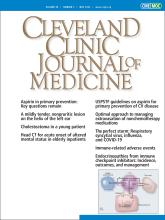A 73-year-old man presented with a mildly tender nonpruritic lesion on his left ear (Figure 1) that had been present for 6 months, having first noticed discomfort when sleeping on a firmer pillow on his left side. There was no history of trauma or excessive sun exposure. The patient was periodically picking off the crust, which would always recur. He reported sleeping exclusively on his left side.
At presentation, the lesion on the helix of the patient’s left ear was mildly tender and nonpruritic, with a central crust overlaying an ulcerated nodule.
Examination revealed a 3-mm lesion on the superior pole of the helix of the ear without erythema. There was a central crust overlaying an ulcerated nodule without discharge or bleeding. The nodule was tender to palpation. Based on the appearance of the lesion and the patient’s history of discomfort after changing to a firmer pillow, the lesion was diagnosed as chondrodermatitis nodularis helicis (CNH).
Our patient was advised to avoid putting pressure on the ear and to sleep on the opposite side.
CHONDRODERMATITIS NODULARIS HELICIS
Classically, CNH is a painful, benign inflammatory nodule or papule on the helix or antihelix of the ear that is tender to touch or pressure.1,2 Typical lesions are unilateral, 4 to 6 mm in size, and consist of an ulcerated nodule with a central crater. Crusting may or may not be present, and some lesions may have a cystic appearance.
CNH is most common in middle-aged to older fair-skinned men and has a variable male-to-female ratio. The etiology of CNH is multifactorial and can be the result of thinning skin and cartilage seen with aging and with degeneration of cartilage from pressure. CNH can often result in sleep disturbances when patients continue to sleep on the affected side. Involvement of the right side may be more frequent.3
The differential diagnosis may include actinic or seborrheic keratosis, basal cell or squamous cell carcinoma, gouty tophi, and keratoacanthoma.1 Patients are often referred to specialists for biopsy evaluation. However, taking a detailed history, specifically about sleeping patterns, in combination with the location of the lesion should help establish the proper diagnosis. Biopsy should be done when the diagnosis is uncertain, when there is a history of skin cancer or sun-damaged skin, or when the lesion does not respond to noninvasive interventions.
TREATMENTS
As the pathophysiology of CNH is thought to be akin to pressure ulcers, treatment is usually with conservative measures such as pressure avoidance or pressure relief by sleeping on the contralateral side, padding of the ear with sponges or foam, and use of a donut pillow. Clinical response to these interventions can obviate the need for biopsy. Other noninvasive therapies include intralesional steroid injections, topical nitroglycerin gel, cryotherapy, carbon dioxide laser therapy, or photodynamic therapy that uses a light source to improve blood flow.2,4 Wedge resection should be considered when the lesion recurs despite multiple attempts of less invasive interventions.
OUR PATIENT’S CASE CONCLUDED
At follow-up 2 months later, our patient reported significant improvement of symptoms, which further solidified the diagnosis of CNH. The lesion was significantly smaller, and the patient was counseled that CNH can frequently recur and that other treatments may be needed.
DISCLOSURES
The authors report no relevant financial relationships which, in the context of their contributions, could be perceived as a potential conflict of interest.
- Copyright © 2023 The Cleveland Clinic Foundation. All Rights Reserved.







